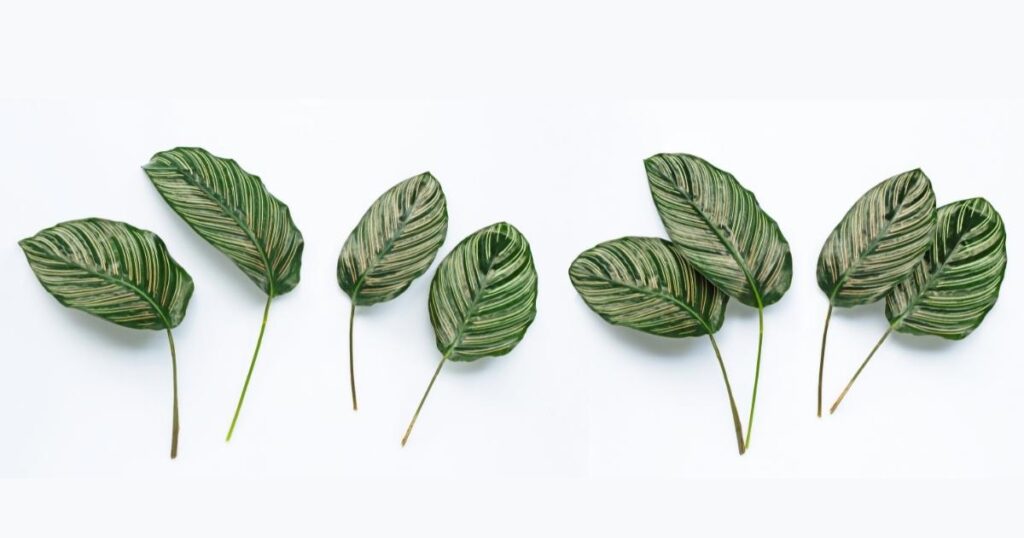If you are a sucker for aesthetics, chances are that you may have added Calathea Ornata Pinstripe to your green garden. Extremely popular for its visual appeal, Calathea Ornata has large green leaves with white or pink stripes and a reddish-purple underside. Native to South America and often found in the tropical regions of Thailand, the plant makes for a spectacular sight indoors as well as outdoors. However, it doesn’t grow more than 2 ft wide and 2 ft tall when kept indoors.
Like any other plant, Calathea Ornata also requires care and attention to grow to its full potential. So if you are looking for answers about Calathea Ornata care, you are at the right place!
Though pleasing to the eyes, this beautiful-looking plant can be difficult to care for at times. Let’s take a look at the answers to common questions about caring for your Calathea Ornata while growing it.
How To Prevent Calathea Ornata’s Curling Leaves?
Calathea Ornata’s curling leaves are an indication that the plant is dehydrated. This may be due to excessive heat, dry air, or underwatering. Prevention is better than cure, hence preventing the leaves from curling is always a better option. As this plant needs high humidity to retain its lush foliage, spraying warm water to mist it can help you maintain the required humid atmosphere. You can use a humidifier or a humidity tray to do this.

Additionally, maintaining plant hygiene can go a long way in avoiding the leaves from curling. Make sure to water them regularly, clean their leaves, maintain the right temperature, and not place it in direct sunlight.
What Are The Calathea Ornata Soil Requirements?
This plant grows best in moist soil. However, the soil should retain moisture but also drain well. This can be achieved by placing clay pebbles at the bottom of the pot as it helps in draining the water efficiently while also helping the nutrients of the soil nourish the plant. It is best to use a plastic pot having drainage holes at the bottom as it maintains moisture and prevents the rotting of the roots.
What Are Calathea Ornata Light Requirements?
This plant needs bright but indirect light. Exposure to direct sunlight for long durations can cause the colors of the leaves to fade and scorch, and thus, give the plant a burnt appearance. While lack of light hampers the growth of the plant, too much of it can also end up killing it. Therefore, an ideal placement for the plant would be a shaded place or have as an indoor plant near a window with thin curtains. This will give adequate but indirect light to the plant.
Why Is My Calathea Ornata Dying?
The most likely cause is root rotting caused due to overwatering of the plant. Other factors can be lack of humidity, direct exposure to bright light, excessive use of fertilizers, dry soil, and spider mites. You can save your plant from dying by making sure that:
- It gets indirect light
- It has moist but not wet soil
- It is placed in a humid atmosphere
- It is treated for pests and insects
What Are The Calathea Ornata Watering Needs?
These plants love to be in humid conditions but hate sitting in water. So, overwatering is a big NO! Make sure to feel the soil and water only when the top layer feels dry. While lack of water will lead to Calathea Ornata leaves curling and browning, overwatering will lead to wilting of the plant. Figure out a watering schedule that suits you and your plant and follow it diligently to avoid any problems. Ensure that the plant is potted in a well-draining pot and is never sitting in a puddle.
What Is The Reason Behind Calathea Ornata’s Yellow Leaves?
Again, overwatering is the most probable reason for yellow leaves. The soil should be moist but not wet, failing which the plant will end up with yellow leaves and rotten roots due to the soggy soil. The other reasons could be low humidity, the wrong type of water, inadequate temperatures, fungal infections, and insufficient or excessive light. It is also possible that the plant may be adjusting to some recent changes done. As this is a plant that doesn’t like changes, it is possible that the yellowing of leaves is a sign of it adjusting to its new surroundings or repotting.
Is Calathea Ornata Pet Safe?
Yes, it is a very pet-friendly plant. It is suitable for cats and dogs alike.. Since these plants are non-toxic to pets, they make an excellent choice for pet parents.
Is Calathea Ornata Toxic For Cats?
Apart from being a style statement in home decor, it is also non-toxic for cats. Hence it’s a safe choice for cat lovers.
Is it Toxic To Dogs?
Absolutely not. Its air purifying qualities are, in fact, helpful for enhancing the quality of air in the surroundings. This makes it a good choice for dog owners.
What Are The Causes Of Calathea Ornata Dry Tips?
The most common causes for dry tips and brown and crispy leaves in this plant are low humidity, inconsistent or improper watering, sunburn, use of hard water, too much fertilization, and pest infestation. The browning of leaf tips and edges may also be due to damaged roots, due to which the plant’s tissues are unable to transport food, minerals, and nutrients to its distant parts. Ensuring your plant gets the right light, adequate water supply, minimum fertilization, and planting it in a pot that drains well will help you keep unwanted dry tips at bay.

